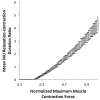Challenging the Cinderella Hypothesis: A New Model for the Role of the Motor Unit Recruitment Pattern in the Pathogenesis of Myofascial Pain Syndrome in Postural Muscles
- PMID: 29944114
- PMCID: PMC6115483
- DOI: 10.5041/RMMJ.10336
Challenging the Cinderella Hypothesis: A New Model for the Role of the Motor Unit Recruitment Pattern in the Pathogenesis of Myofascial Pain Syndrome in Postural Muscles
Abstract
Background: The energy crisis hypothesis, which is a widely accepted model for the pathogenesis of myofascial pain, has been corroborated by experimental observations. However, the nature of the insult leading to the energy crisis remains elusive. A commonly cited model for this insult is the Cinderella hypothesis, suggesting that hierarchical recruitment of motor units leads to a disproportional load on small units, thus driving them towards an energy crisis. New findings cast doubt on this model, showing that in postural muscles motor units are recruited in rotation, rather than in a hierarchical order, precluding the formation of the so-called Cinderella units.
Objective: To explore the influence of common myofascial predisposing factors such as muscle load and muscle strength on the relaxation time of postural muscle motor units, assuming they are recruited in rotation.
Methods: A stochastic model of a postural skeletal muscle was developed which integrates the energy crisis model and motor unit rotation patterns observed in postural muscles. Postulating that adequate relaxation time is essential for the energetic replenishment of motor units, we explored the influence of different parameters on the relaxation time of individual motor units under varying conditions of muscle loads and muscle strengths.
Results: The motor unit relaxation/contraction time ratio decreases with elevated muscle loads and with decreased total muscle strength.
Conclusions: In a model of a postural muscle, in which motor units are recruited in rotation, common predisposing factors of myofascial pain, such as increased muscle load and decreased muscle force, lead to shortened motor unit relaxation periods.
Conflict of interest statement
Figures




References
-
- Sola AE, Rodenberger ML, Gettys BB. Incidence of hypersensitive areas in posterior shoulder muscles; a survey of two hundred young adults. Am J Phys Med. 1955;34:585–90. - PubMed
LinkOut - more resources
Full Text Sources
Other Literature Sources
Miscellaneous

